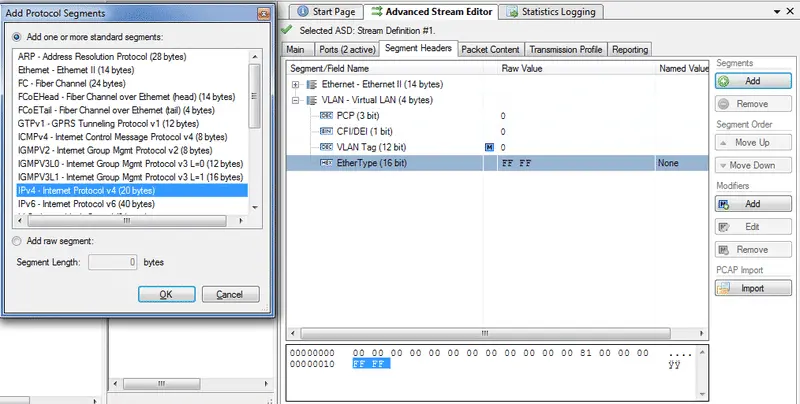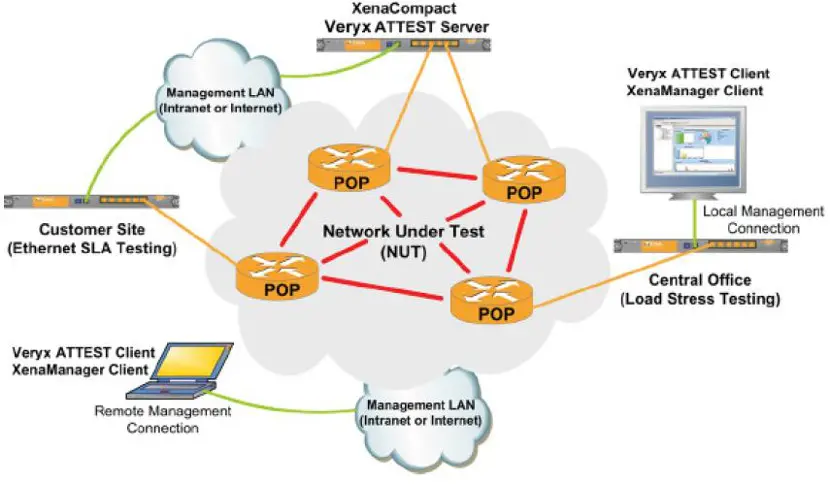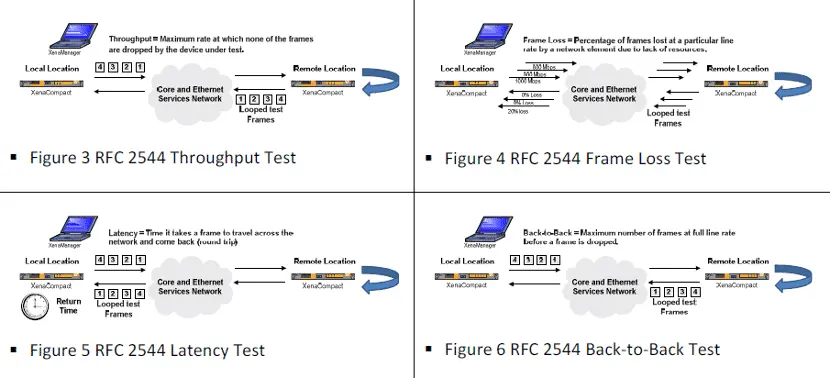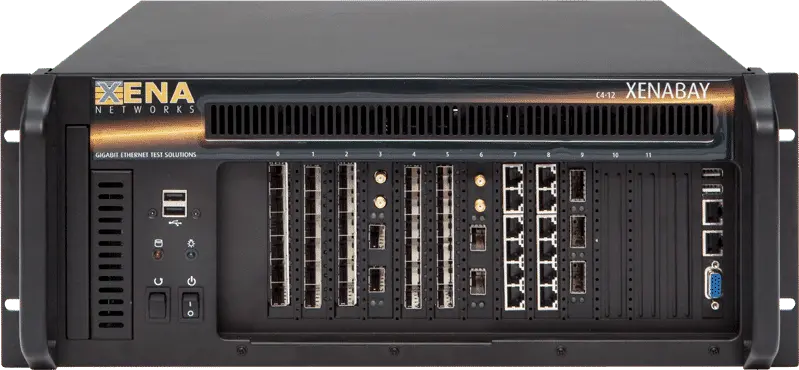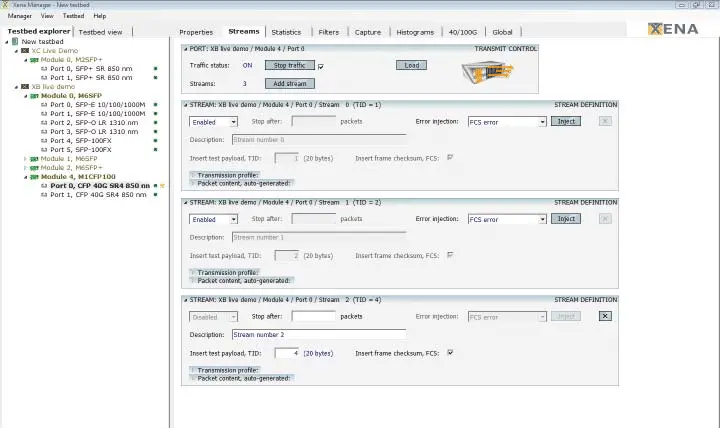Test your network and applications
through network traffic generators
and determine their performance
The best price in relation to performance - modular 100Gbps solutions
Xena Networks provides a new class of professional Gigabit Ethernet testers which set new standards when it comes to price vs. performance including load and functional tests on Ethernet devices and networks.
Suppliers of Ethernet network devices and service providers will benefit from the fact that Xena Network’s test platform is easy to use, cost efficient, interoperable and scalable. It’s also the world’s best test port since it has the highest density and lowest power consumption, providing a test platform that’s fit for the future. Developers, systems integrators and those who provide solutions for Ethernet network equipment can implement Xena Network’s test platform along with, or as a substitute for, test equipment by Ixia and Spirent. The price offered beats developing in-house test solutions.
High-precision, stream-based, wire-speed traffic is generated and analysed to test network devices under specific predetermined conditions including errors, different loads and random events. Packet formats are defined through individual packet bytes, packet spacing, transmission rates and bursts, which are measured with byte and Kbps accuracy.
Manufacturers of network equipment and service providers can prove their guarantee of triple play QoE for the end user when faced with network congestion. This is achieved by generating traffic loads that mimic tens of thousands of individual users.
For ad-hoc testing, a free Windows interface is included (XenaManager). In addition, remote management is provided for test equipment in different locations as well as GUI clients for automated testing for RFC 2544 (known as Xena2544) and Y.1564 (using Xena1564).
Users can automate testing in any software environment thanks to an open TCP/IP-based text API and convert both to and from generic Xena’s Command Line Interface (CLI) using Perl, VBA, Tcl, Java wrappers and Python. The Xena Networks test platform offers a full suite of copper and optical Gigabit Ethernet products as well as 10/40/100 Gigabit Ethernet modules.
The 10/40/100 Gigabit Ethernet interfaces include optical SFP+, XFP, SR4, LR4, and SR10. The Gigabit Ethernet interfaces include 10/100/1000M copper Ethernet and optical 100/1000M Ethernet.
Test Components
Xena Networks has developed a flexible layer 2-3 testing platform with a high port density, which can easily be used alongside test software from third parties, including Veryx ATTEST. The clients are connected to the test platform by means of Gigabit Ethernet interfaces and this method supports remote access through IP addressing.
Xena’s wire-speed test module comes in two highly compact versions, which are 1U (XenaCompact) and 4U (XenaBay). These provide full support in multi-user environments for GUI and automated test sessions.
Data Stream-Oriented Traffic Generation
A user can generate hundreds of transmit/receive streams, each with their own traffic profiles. Each data stream can produce up to 100,000 individual traffic flows using programmable packet field modifiers for incremental or randomly generated field values, such as MAC addresses, IP addresses or VLAN identifiers. This helps you to scale your tests based on the maximum parameters of your device or network.
Users can specify the stream rate to reflect a certain percentage of the total line rate. The stream rate can also be set according to bit rate and frames per second. Data packets can be introduced as a one-off packet shot or as multiple packets based on duration in terms of time. Continuous mode is also an option. Users can set traffic profiles that are either uniform or run in bursts.
A graphic field editor processes individual packets and using predefined packet templates, various packet formats can be created for Ethernet, Ethernet II, ARP, VLAN, IPv4, IPv6, UDP, LLC, TCP, GTP, SNAP, MPLS, ICMP, STP, SCTP, RTP, RTCP, PBB, FCoE and IGMPv2/3. The user is also able to specify their own format.
Analyzes and Reports in Real-Time
Flow statistics are produced per stream or based on user-defined filters, which can be specified to use different combinations of programmable field values. Automatic test payload fields can be optionally inserted to identify incoming packet streams.
Analysis of traffic latency, throughput, jitter, sequence, loss and request errors are created for each stream of realtime data with an accuracy of 16/32 ns. This depends on the type of interface and whether it’s optical or electrical. Users can record the wire-speed of packets for analysis from any port and export using the Hotbutton to Wireshark or OmnniPeek analysis tools. The latter offers unique opportunities to identify and isolate performance problems associated with event triggering and programmable filters.
API scripting from any tool environment with XenaScripting-XenaScripting is a free and open API specification of a Command Line Interface (CLI) and users can create scripts so that tests are automated regardless of the scripting environment or tool used. The only condition is that the scripting environment must support text and line-based TCP/IP communications.
Changes made using XenaScripting are automatically displayed in the user interface. Users can log in to Xena’s test platform from any scripting environment including local and commercial settings thanks to Xena’s user-friendly unique scripting that can be used anywhere. The scripting environment uses languages such as Tcl, Python, Perl, VBA and Java. Wrappers are used to convert existing script APIs into the generic Xena API.
Microsoft Excel provides another option for the user to configure and run tests as well as produce reports. This is an alternative to GUI and other test scripts and allows a user to configure, use and log statistics through the familiar Excel application.
Xena provides templates for MS Excel using VBA to communicate with the test environment.
This is achieved using Xena TCP/IP settings and anyone who’s familiar with MS Excel will find it’s a powerful way to operate.
Data Stream Method and Network Flow Transfer Method
- Overlapping or sequential data stream
- Generation of bursts or continuous sending of a fixed packet number of 1 to 4 billion packets
- Latency measurement over several ports with an accuracy of 16/32 ns, depending on the interface type (optical/electrical)
- Constant (100% uniform) as well as distributions in bursts
- Loads can be set to be a percentage of the line rate, frames per second or Megabytes per second
- Burst parameters are defined in the packet header by burst length and density
- Specified by the user or Ethernet, Ethernet II, ARP, VLAN, UDP, IPv4, IPv6, TCP, SNAP, LLC, GTP, RTP, RTCP, ICMP, STP, SCTP, PBB, MPLS, IGMPv2/3, FCoE
- Any field within the packet template can be set to invalid values for negative tests
- Incremental 8-bit pattern
- PRBS-31
- Automatic fill with a user defined pattern
- Up to five field modifiers can be applied within the packet for each stream. The modifiers can be chained together.
- A field modifier can be set to increase incrementally or decrease to a random value within a specific range. For example, incremental VLAN ID and traversing the IP ToS field.
- Fixed – sämtliche Frames des Datenstroms werden mit derselben Länge gesendet
- Incremental increase/decrease – from a specified minimum and maximum length
- Random – random selection from a range between a specified minimum and maximum length
- Butterfly – uniform selection from a range between a specified minimum and maximum length
- MIX – approximation of Internet traffic with typical packet lengths from 56-1518 Bytes

Test-Load
There’s an option to automatically set up a proprietary test load in packet form. This allows the test platform to show packet loss per stream, min/max/average latency, load integrity, sequence errors and incorrect request statistics.
Checksum Calculations
The FCS and CRC values of packet templates can be calculated automatically or set to incorrect values.
Statistics per Port
- Packets/octets per port, FCS errors, packets/octets for traffic with and without a test load
- Packets/octets for up to six custom traffic filters which are fully user-definable, using up to six individual patterns and length comparison values
- Technical specifications during equipment tests can be changed, even if packets are received with different encapsulations or with modified content
- Test packets/octets, sequence errors, packets that are requested incorrectly, load integrity, minimum and maximum latency, average latency, minimum noise, average noise, maximum interference
Packet Capture
- Triggers and filters can be set so that they are triggered in the event of certain events and tap into packets that meet specific criteria
- Using AND/OR expressions more criteria can be specified
- The criteria can be completely user-defined or determined by using a predetermined filter
- Export via Hotbutton to the Wireshark analysis tool
Capture Criteria
- Any combination of custom multiple packet field values
- Packets with FCS errors
- Packets belonging to a specific data stream
- Packets that meet user-defined filter criteria, for example, IPv4, IPv6, VLAN, UDP
Capture Triggers
- Jeder empfangene Frame
- Packets that meet user-defined filter criteria, for example, IPv4, IPv6, VLAN, UDP
- Packets with FCS errors
Lab Tests
Xena Networks’ test platform is designed to carry out hardware tests and negative tests in development environments. This allows tests can be carried out across multiple ports at a fraction of the cost of existing test solutions.
In the past, manufacturers made commercial test platforms with internally-built PC/FPGA platforms and the Xena Networks solution is an ideal replacement for these. For network devices with a lower capacity of only 1 or 2 Gbit or 10Gbit Ethernet ports, a single 1U is enough for the Xena test system to generate wire-speed tests and analysis.
Key features include wire-speed generation of traffic and analysis, a GUI framework, an open protocol for TCP/IP scripts and integration with a wide range of function and conformity tests.
Network Infrastructure Testing
Ethernet access, aggregation and regional transmission networks are increasingly used all over the world. Many operators already use anything from 1 to 10 Gbit/s Ethernet transmissions between sites and aggregation points.
To remain competitive, network service providers must check their network performance SLAs according to peak times. This will help to determine what can be guaranteed to the end user in various network scenarios. Xena Network’s test platform promotes efficient remote IP management, compact form factor and wire-speed Layer 2-3 stress tests to help the transmission link or network to work at full capacity.
This is achieved by sending hundreds of Gbit/s of test traffic through multiple network access points.


